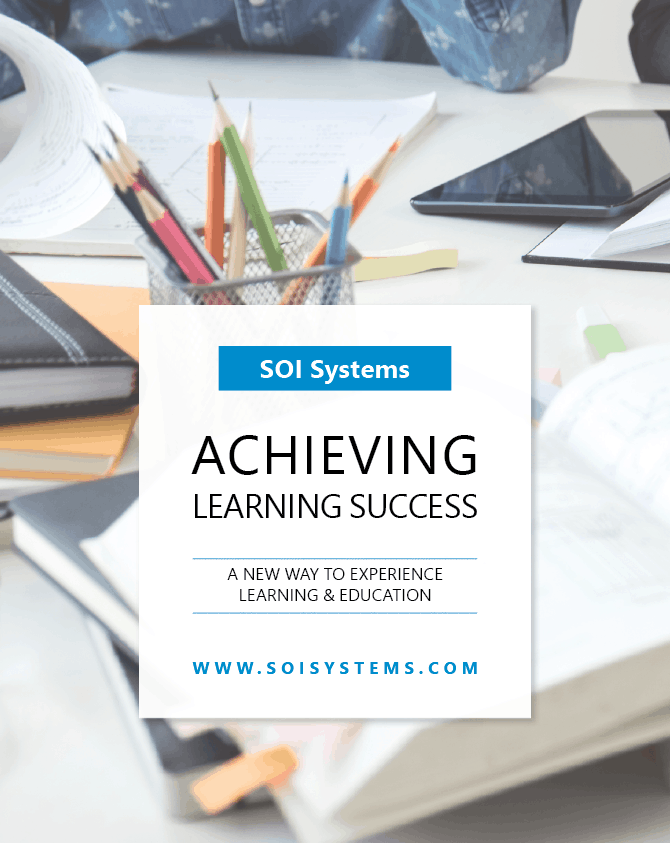SOI stands for
"Structure of Intellect."
We are dedicated to changing the way that people learn. Our goal is for everyone to be a successful learner.
We know that learning can be hard, and we’re here to help change that. We work with every type of person in every learning situation – parents, students, teachers, individuals, special education instructors, tutors, and more.
- intelligence can be trained with SOI
- low learning abilities are improved & strong ones are enhanced
- we have tests and training materials for grades pre-k to adult
- we work to understand & address the cause of learning difficulties
- the SOI approach makes traditional education more successful
- general academic issues
- lack of memory skills
- low math skills
- poor reading comprehension
- anxiety over school or work
- poor handwriting
- homework taking too long
- difficulty following instructions
- inability to focus
- general behavioral issues
- social issues
- difficulty sitting still
The Key to Learning
SOI stands for Structure Of Intellect – a theory of human intelligence which describes the abilities for acquiring, assimilating, and processing information – the basis of human learning. Dr. Mary Meeker saw the potential for diagnosing learning difficulties, and realized that certain intellectual abilities were related to basic learning. She also discovered that intellectual abilities could also be taught and improved.
This close coupling between assessment and training is what makes SOI unique. Our assessments are used to measure intellectual abilities; SOI training materials are used to develop intellectual abilities that are weak and further enhance abilities that are strong.
To empower individuals to develop the ability to learn with confidence, accuracy, stamina, and determination is the foundation of SOI Systems. Dr. Mary and Dr. Robert Meeker developed the key to learning.
What makes SOI Different?
SOI is unique because we can: find the problem, provide a solution, and make sure that there is improvement.
Everyone has their own learning style. SOI trains cognition, memory, evaluation, convergent production, and creativity to a person’s strongest learning style so they “get it.” What do you think your learning style is?
Figural Learning Style
Symbolic Learning Style
Semantic Learning Style
Semantic content deals with concepts and ideas. It is the principal content in school. Semantic learners are good at processing the conceptual content of language and thus are at an advantage for learning! Conversely, those students who are not good at processing the conceptual content of language are at a disadvantage.
The SOI Process
1. ASSESS
SOI tests are the best way to get a snapshot of the person’s learning abilities and to see their learning potential. So much information is revealed as to how information is processed, understood, remembered, evaluated, used to solve problems, and used creatively.
2. IDENTIFY
Find out what areas – such as comprehension, evaluation, problem-solving, or memory – may be causing difficulties, and see what areas are already strong. Not only does it identify areas of concern, it identifies areas of strength that the student or adult has not been aware of. Understanding areas of strength allows for a feeling of empowerment to face challenges in learning or in life with an increased confidence!
3. TRAIN
Personalized training materials in the form of paper-pencil and/or computer modules are available based on SOI assessment results. This is a tool to help individualize education. Low abilities are targeted at the beginning of the program. Average to high abilities are further strengthened. Teach abilities which are low, maintain those that are gifted, and further develop any that are average. The focus is on identifying and eliminating the source of the learning problem rather than a palliative treatment of the symptoms.
Learning Abilities
Our goal is to develop the lifelong learning abilities that you need in order to be successful in school, your career, and life in general.
COGNITION
This is the ability to assimilate new material or to recognize material that has been encountered before. People in education use the term “comprehension” to mean the same as the Structure of Intellect term “cognition.”
Examples of strong cognition abilities include: excellent comprehension of visual details, the ability to see spatial relationships, and understanding meanings and nuances.
MEMORY
Memory is the ability to recall previously cognized material. Memory is the counterpart to Cognition. Cognition is the ability to “take-in” information; Memory is the ability to “bring-back” information.
Examples of strong memory abilities include: being good with visual details, being able to remember incidental information, and having a strong memory for auditory details.
EVALUATION
Evaluation is the ability to make practical judgments or decisions. Evaluation is required in situations that involve incomplete information – either ambiguity or uncertainty.
Examples of strong evaluation abilities include: the ability to make visual judgements and conceptualize symbolic data.
PROBLEM SOLVING
Problem solving is the ability to arrive at a determinate answer from the information given. It is the ability used in rule-following.
Examples of strong problem solving abilities include: being neat and careful with details, having a good command of arithmetic processes, and being able to scan data rapidly.
CREATIVITY
Creativity is freedom of expression in writing, drawing, numbers, and more. It is the idea of “thinking outside the box.”
Examples of strong creativity abilities include: having good fluency and confidence with ideas, being able to produce ideas and put them together, and solving problems in unique ways.


